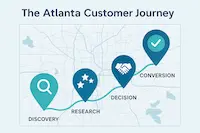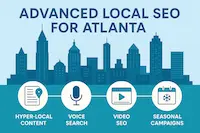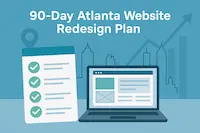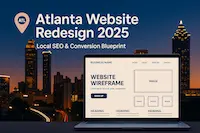
7 Hidden Technical SEO Mistakes Killing Your Google Rankings (2025 Fixes)
7 Hidden Technical SEO Mistakes That Are Killing Your Website's Google Rankings (And How to Fix Them in 2025)
Your website looks beautiful. Your content is engaging. But somehow, you're still invisible on Google. Sound familiar? If you're scratching your head wondering why your website isn't ranking, the culprit might be lurking in your site's technical foundation.
After auditing hundreds of websites in 2025, we've discovered that 73% of businesses are making critical technical SEO mistakes that Google's algorithm simply can't ignore. The good news? These issues are fixable, and once resolved, many of our clients see ranking improvements within 30-60 days.
1. Your Core Web Vitals Are Failing (And You Don't Even Know It)
The Problem:
Core Web Vitals became a ranking factor in 2021, but in 2025, Google has made them even more critical. Having a good technical SEO structure leads to a better user experience, which means increased dwell time, conversions, and sales.
What to Check:
- Largest Contentful Paint (LCP): Should be under 2.5 seconds
- First Input Delay (FID): Should be under 100 milliseconds
- Cumulative Layout Shift (CLS): Should be under 0.1
How to Fix It:
- Optimize Images: Use WebP format and proper sizing
- Minimize JavaScript: Remove unused code and defer non-critical scripts
- Improve Server Response Time: Upgrade hosting or implement CDN
- Eliminate Layout Shifts: Set dimensions for all media elements
Quick Win: Run your site through Google PageSpeed Insights right now. If your mobile score is below 70, you're likely losing potential customers every day.
2. Your Website Isn't Truly Mobile-First (Despite What You Think)
The Reality Check:
"Mobile-friendly" isn't enough in 2025. Your site needs to be mobile-first, meaning it's designed and optimized primarily for mobile devices, not just adapted from a desktop design.
Common Mobile Issues We Find:
- Text too small to read without zooming
- Links too close together for touch navigation
- Content wider than the screen
- Pop-ups that can't be dismissed on mobile
- Forms that don't work properly on touch devices
The Fix:
- Test on Real Devices: Don't just use browser dev tools.
- Implement Progressive Web App (PWA) Features: Add offline functionality for a more app-like experience.
- Optimize Touch Targets: Make buttons at least 44px in size.
- Simplify Navigation: Use hamburger menus and collapsible sections.
3. Your Site Architecture Is Confusing Google's Crawlers
The Problem:
If Google can't easily crawl and understand your site structure, it can't rank your pages effectively. A confusing architecture is like a library with no signs—users and bots get lost.
Warning Signs:
- Pages are more than 3 clicks from the homepage
- No clear internal linking strategy
- Missing or incorrect XML sitemaps
- Broken internal links
- Orphaned pages (pages with no internal links pointing to them)
The Solution:
- Create a Logical Hierarchy: Use a pyramid structure with your homepage at the top.
- Implement Breadcrumbs: Help users and search engines understand page relationships.
- Build Strategic Internal Links: Link to important pages from multiple relevant locations.
- Update Your XML Sitemap: Include all important pages and keep it current.
4. Your Schema Markup Is Missing or Broken
Why This Matters:
Schema markup (structured data) helps search engines understand your content's context, leading to rich snippets, better visibility in search results, and eligibility for AI-driven answers.
Essential Schema Types for Most Businesses:
- Organization schema (for your business info)
- LocalBusiness schema (if you serve local customers)
- Service schema (for your service pages)
- Review schema (for testimonials)
- FAQ schema (for frequently asked questions)
Implementation Tips:
- Use Google's Rich Results Test to validate your markup.
- Focus on schema types relevant to your business.
- Keep your schema updated with current information.
- Test how your rich snippets appear in search results.
Implementation Example: LocalBusiness Schema
<script type="application/ld+json">
{
"@context": "https://schema.org",
"@type": "LocalBusiness",
"name": "TiltStack Web Development",
"url": "https://www.tiltstack.com",
"address": {
"@type": "PostalAddress",
"addressLocality": "Atlanta",
"addressRegion": "GA"
}
}
</script>
Quick Win: Use Google's Rich Results Test to validate your markup and check for errors.
5. Your HTTPS Implementation Has Security Gaps
The Issue:
Just having an SSL certificate isn't enough. Mixed content (loading insecure HTTP resources on a secure HTTPS page) or improper redirects can create security warnings and hurt your rankings.
What to Audit:
- Mixed Content: Check your browser's console for "mixed content" warnings.
- Redirects: Ensure all HTTP versions of your URLs properly 301 redirect to the HTTPS version.
- HSTS Headers: Implement HTTP Strict Transport Security (HSTS) to enforce secure connections. Read more about HSTS at the MDN Web Docs.
How to Fix:
- Audit All Content: Ensure all images, scripts, and resources load over HTTPS.
- Update Internal Links: Change all internal links to their HTTPS versions.
- Implement HSTS: Add the Strict-Transport-Security header.
- Check Third-Party Integrations: Ensure all external tools and scripts support HTTPS.
6. Your JavaScript Is Blocking Critical Rendering
The Problem:
Heavy or poorly implemented JavaScript can delay a page from becoming visible and interactive, hurting user experience and Core Web Vitals.
Solutions:
- Defer Non-Critical JavaScript: Load scripts that aren't needed for the initial view (like chat widgets or analytics) after the main content has rendered.
- Use
asyncLoading: For scripts that can run independently without blocking other elements. - Minimize and Compress: Reduce JavaScript file sizes through minification.
- Implement Code Splitting: Load only the necessary JavaScript code for each specific page.
7. Your URL Structure Is SEO-Unfriendly
Common URL Problems:
- Dynamic URLs with long query parameters (e.g.,
?id=123&cat=web). - URLs that don't reflect the content hierarchy.
- Missing canonical tags, causing duplicate content issues.
Best Practices:
- Use Clean, Descriptive URLs:
/services/web-development/is better than/page?id=123. - Implement Canonical Tags: Specify the preferred version of any similar or duplicate pages.
- Create a Logical URL Hierarchy: Your URLs should match your site's structure (e.g.,
.../services/web-design/). - Avoid URL Parameters for Indexable Content: When possible, use clean paths.
How to Conduct Your Own Technical SEO Audit
Free Tools to Use:
- Google Search Console: Essential for monitoring crawl errors, indexing status, and Core Web Vitals.
- Google PageSpeed Insights: The definitive source for checking Core Web Vitals and performance.
- GTmetrix: Provides detailed analysis of page speed and optimization opportunities.
- Screaming Frog SEO Spider: The industry-standard tool for crawling your site like a search engine to find technical issues (the free version crawls up to 500 URLs).
Step-by-Step Process:
- Start with Google Search Console: Fix any critical errors it reports first.
- Run a Site Crawl: Use Screaming Frog to identify issues like broken links, missing meta tags, and redirect chains across all pages.
- Check Mobile Usability: Test on multiple real devices and use Google's Mobile-Friendly Test.
- Analyze Page Speed: Run your most important pages (homepage, key service pages) through PageSpeed Insights.
- Review Site Architecture: Ensure a logical structure and strong internal linking.
The Bottom Line
Technical SEO might not be glamorous, but it's the foundation upon which your entire digital marketing strategy is built. In 2025, search engines are better than ever at rewarding sites that provide a flawless user experience.
While content and backlinks get most of the attention, technical SEO is often the difference between ranking on page 1 and being buried on page 10. Regular audits and updates are essential for maintaining and improving your rankings.
Need Help?
If you're feeling overwhelmed by these technical requirements, you're not alone. At TiltStack, we specialize in identifying and fixing these hidden problems that prevent websites from reaching their full potential.
This guide was created by the team at TiltStack, a web development agency specializing in technical SEO and performance optimization. We've helped hundreds of businesses fix their technical SEO issues and improve their search rankings.

















































